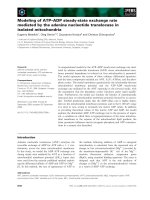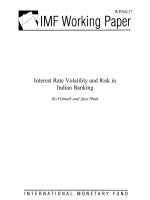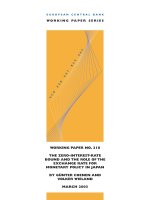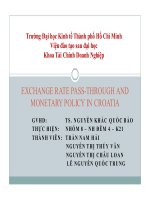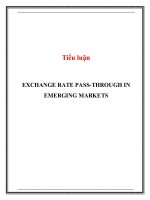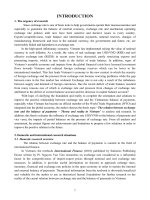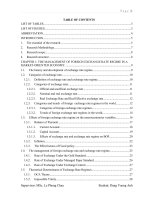Modelling long memory in exchange rate volatility
Bạn đang xem bản rút gọn của tài liệu. Xem và tải ngay bản đầy đủ của tài liệu tại đây (1.18 MB, 99 trang )
MODELLING LONG MEMORY IN
EXCHANGE RATE VOLATILITY
HO KIN YIP
NATIONAL UNIVERSITY OF SINGAPORE
2003
MODELLING LONG MEMORY IN
EXCHANGE RATE VOLATILITY
HO KIN YIP
(B.Soc.Sci.(Hons.) B.A., NUS)
A THESIS SUBMITTED
FOR THE DEGREE OF MASTER OF SOCIAL SCIENCES
DEPARTMENT OF ECONOMICS
NATIONAL UNIVERSITY OF SINGAPORE
2003
ACKNOWLEDGEMENTS
I wish to thank the following people:
•
•
•
•
•
•
•
•
•
My supervisor/advisor, Associate Professor Albert Tsui;
Professor Parkash Chander;
Associate Professor Peter Wilson;
Assistant Professor Mark Donoghue;
Assistant Professor Lee Jin;
Professor John Dalle Molle;
Professor James Ramsey, President of the Society for Nonlinear Dynamics
and Econometrics (SNDE), Ulrich Mueller of Converium, and other
participants of the 11th Annual Symposium of the SNDE;
The administrative officers of the Dean’s Office at the Faculty of Arts and
Social Sciences;
My parents.
i
TABLE OF CONTENTS
TITLE
PAGE
ACKNOWLEDGEMENTS
i
TABLE OF CONTENTS
ii
LIST OF TABLES
iii
LIST OF FIGURES
v
SUMMARY
vi
CHAPTER 1:
INTRODUCTION: MODELLING LONG MEMORY PROCESSES
1.1 An Overview of Long Memory
1.2 Definitions and Theoretical Models of Long Memory
1.3 Empirical Applications of Long Memory Models
1
CHAPTER 2:
LONG MEMORY IN VOLATILITY: A MULTIVARIATE
ASYMMETRIC GARCH APPROACH
2.1 Multivariate GARCH Models
2.2 Long-Memory GARCH Models
2.3 Econometric Methodology
2.4 Empirical Applications
8
CHAPTER 3:
MODELLING LONG MEMORY IN EXCHANGE RATE VOLATILITY
3.1 Stylised Facts of Exchange Rate Data
3.2 Data
3.3 Estimation Results
23
CHAPTER 4:
CONCLUSION
78
APPENDIX I:
CONDITIONAL VARIANCE EQUATIONS
80
APPENDIX II:
DATA SETS
81
BIBLIOGRAPHY
82
ii
LIST OF TABLES
Table 3.1: Summary Statistics of Exchange Rates against the Japanese Yen
and the US Dollar
Table 3.2: Unit Root Tests
Table 3.3: Estimation Results of Bivariate VC-GARCH(1,1) Model
Table 3.4: Estimation Results of Bivariate VC-APARCH(1,1) Model
Table 3.5: Estimation Results of Bivariate VC-QGARCH(1,1) Model
Table 3.6: Estimation Results of Bivariate VC-AGARCH(1,1) Model
Table 3.7: Estimation Results of Bivariate VC-FIGARCH(1,1) Model
Table 3.8: Estimation Results of Bivariate VC-FIAPARCH(1,d,1) Model
Table 3.9: Estimation Results of Bivariate VC-FIAGARCH(1,d,1) Model
Table 3.10: Estimation Results of Tetravariate Varying-Correlations (VC)
Model
Table 3.11: Estimation Results of Tetravariate Varying-Correlations
Fractionally Integrated (VC-FI) Model
Table 3.12: Likelihood Ratio Test: Bivariate VC and VC-FI Models
Table 3.13: Likelihood Ratio Test: Bivariate VC and VC-FI Models
Table 3.14: Likelihood Ratio Tests of Tetravariate Models
Table 3.15: Likelihood Ratio Tests of Tetravariate Models
Table 3.16: Standardised Residuals of Bivariate VC-APARCH(1,1) Model:
USD Rates
Table 3.17: Standardised Residuals of Bivariate VC-APARCH(1,1) Model:
JPY Rates
Table 3.16: Standardised Residuals of Bivariate VC-APARCH(1,1) Model:
USD Rates
Table 3.18: Standardised Residuals of Bivariate VC-FIAPARCH(1,1) Model:
USD Rates
iii
Table 3.19: Standardised Residuals of Bivariate VC-FIAPARCH(1,1) Model:
JPY Rates
Table 3.20: Standardised Residuals of Tetravariate VC-APARCH(1,1) and
VC-FIAPARCH(1,d,1) Model: JPY Rates
Table 3.21: Standardised Residuals of Tetravariate VC-APARCH(1,1) and
VC-FIAPARCH(1,d,1) Model: USD Rates
Table 3.22: Cross-Product of Standardised Residuals of Tetravariate VCAPARCH(1,1) and VC-FIAPARCH(1,d,1) Model: JPY Rates
Table 3.23: Cross-Product of Standardised Residuals of Tetravariate VCAPARCH(1,1) and VC-FIAPARCH(1,d,1) Model: USD Rates
iv
LIST OF FIGURES
Figure 3.1: Bilateral Exchange Rates Against the Japanese Yen
Figure 3.2: Bilateral Exchange Rates Against the Japanese Yen
Figure 3.3: Conditional Correlations from Tetravariate VC-FIAPARCH
Model: JPY Rates
Figure 3.4: Conditional Correlations from Tetravariate VC-FIAPARCH
Model: USD Rates
Figure 3.5: Conditional Correlations from Tetravariate VC-APARCH Model:
JPY Rates
Figure 3.6: Conditional Correlations from Tetravariate VC-APARCH Model:
USD Rates
Figure 3.7: Conditional Standard Deviation from Tetravariate VC-APARCH
Model
Figure 3.8: Conditional Standard Deviation from Tetravariate VC-FIAPARCH
Model
v
SUMMARY
Understanding exchange rate dynamics has been an important research topic in
both finance and economics. For example, international capital asset pricing
models often require specific assumptions of exchange rate dynamics; whereas
in economics, there is a need to link exchange rate behaviour to changes in key
macroeconomic variables in order to establish a framework to assess
government policies. Among others, several empirical regularities in exchange
rate dynamics are observed by such researchers as Hsieh (1989a, 1989b, and
1993), Tse and Tsui (1997), and Tse (1998). They include: [1] exchange rate
changes may not be IID; [2] there is little serial correlation in the exchange rate
return series; [3] exchange rate changes indicate volatility clustering and
leptokurtosis; [4] asymmetric effects in exchange rate volatility may not be
present; [5] exchange rate changes may exhibit significant persistence and
dependence between distant observations, which is conveniently described as
“long range dependence” or “long memory”. Most studies that highlight such
empirical regularities are based on the univariate version of Engle’s (1982)
autoregressive conditional heteroskedasticity (ARCH) and Bollerslev’s (1986)
generalised ARCH (GARCH) models and their extensions. These studies
generally find that the class of univariate ARCH and GARCH models is capable
of characterising the non-linear dynamics in exchange rates.
One major drawback of the univariate GARCH framework is that it does not
capture the co-movements of several time series variables, which may be
vi
influenced by the same set of events. Hence, a natural extension is to consider
the multivariate GARCH set-up. Several works on modelling exchange rate
volatility in multivariate contexts include Diebold and Nerlove (1989), Bollerslev
(1990), Engle and Gau (1997), and Engle (2000), among others. However, the
multivariate GARCH approach inevitably increases the number of parameters to
be estimated and complicates the specification of the variance-covariance matrix.
More specifically, it can be difficult to ensure that the variance-covariance matrix
is positive-definite, let alone imposing it during estimation. To circumvent these
problems, Bollerslev (1990) proposes the constant correlations (CC)-GARCH
model. Although this model is relatively tractable, its validity has been questioned
in certain contexts (Tsui and Yu (1999), Tse (2000), Engle and Sheppard (2001),
Engle (2002), and Tse and Tsui (2002)). Indeed, there is some empirical
evidence suggesting that exchange rate correlations may be significantly timevarying (Engle (2002), and Tse and Tsui (2002)). As such, it is more apposite to
consider multivariate models that include time-varying correlations.
Due to the computational complexities involved, there are only a few studies on
modelling long-memory in volatility using the multivariate GARCH framework.
They include Teyssiere (1997, 1998), and Brunetti and Gilbert (2000). These
studies have mainly applied the multivariate version of the fractionally integrated
GARCH (FIGARCH) model of Baillie, Bollerslev, and Mikkelsen (1996) to stock
market and exchange rate data. However, the issue of asymmetric conditional
volatility has been excluded.
Furthermore, such studies mostly assume the
vii
bivariate constant conditional correlation structure (Bollerslev (1990)) for
convenience. Although Teyssiere (1998) also considers a trivariate unrestricted
FIGARCH model based on the vech structure, his model requires implementing a
set of conditions to ensure that the variance-covariance matrix is positivedefinite. In this paper, we propose a family of multivariate (bivariate, trivariate,
and tetravariate) asymmetric GARCH models to analyse the volatility dynamics
of exchange rates. The proposed models can capture the stylised features of
long-memory, persistence, asymmetric conditional volatility, and time-varying
correlations commonly found in financial time series data. Furthermore, our
model automatically satisfies the positive-definite condition when convergence is
achieved. A total of 26 different models (see Appendix I) are applied to four
currencies: the Canadian dollar, the British pound, the Singapore dollar, and the
Malaysian ringgit. We want to point out that previous studies on exchange rate
behaviour have predominantly concentrated on the bilateral exchange rate
against the US dollar. Our approach departs from this widely accepted
convention. Instead, we also choose the Japanese yen as an alternative
numeraire currency to the US dollar. It is interesting to investigate the dynamics
of exchange rates against this alternative as it has important implications for
asset allocation, such as the construction of a diversified Asian asset portfolio.
Our main findings are as follows. First, evidence of long-memory and persistence
in volatility is detected in the individual exchange rate return series, regardless of
the choice of the numeraire currency. Furthermore, some exchange rates, such
viii
as the JPY rates, apparently share the same degree of long memory in their
conditional variances. In addition, by comparing the log-likelihood values, the
multivariate fractionally integrated models generally outperform those models
without long-memory structures in the conditional variance.
Second, consistent with previous studies, such as Hsieh (1993), and Tse and
Tsui (1997), the Canadian dollar, the British pound, and the Singapore dollar visà-vis the US dollar do not exhibit asymmetric effects in the conditional volatility.
In contrast, we detect reasonably stronger evidence of asymmetric conditional
volatility for these currencies when the numeraire currency is the Japanese yen.
Additionally, the depreciation shocks of the Malaysian ringgit have a greater
impact on future volatilities compared with the appreciation shocks of the same
magnitude, and this result is robust to the choice of the numeraire currency.
Furthermore, the significance and the magnitude of asymmetric effects can vary
according to how the conditional variance equation is specified.
Third, we find new evidence of time-varying correlations among the currencies
when they are measured against the Japanese yen. For example, similar to
results in Tse (2000), we do not find strong evidence of time-varying correlations
between the Singapore dollar and the Malaysian ringgit when the numeraire
currency is the US dollar. However, time-varying correlations between these
currencies are detected when the Japanese yen is used.
ix
CHAPTER 1
INTRODUCTION: MODELLING LONG MEMORY PROCESSES
1.1
An Overview of Long Memory
The phenomenon of long memory (or long range dependence) has been known long
before suitable statistical models are developed to characterise it. Since ancient times,
Egyptian hydrologists who studied the flows of the Nile River had noted that long periods
of dryness were followed by long periods of yearly returning floods. This behaviour was
described in the Bible (Genesis 41, 29-30): “Seven years of great abundance are coming
throughout the land of Egypt, but seven years of famine will follow them.” Mandelbrot
called this behaviour the “Joseph effect” (Mandelbrot 1977, 1983). See also Hurst (1951,
1956), Lawrance and Kottegoda (1977), and McLeod and Hipel (1978). Indeed, the
origin of interest in long memory processes appears to have come from the examination
of data in the physical sciences such as hydrology and climatology and preceded
interest from econometricians.
The presence of long memory can be formally analysed from an empirical, data-oriented
approach in terms of the persistence of observed autocorrelations. The degree of
persistence is consistent with an essentially stationary process; however, the
autocorrelations take far longer to decay than the exponential rate associated with Box
and Jenkin’s (1970) autoregressive-moving average (ARMA) class of models. When the
phenomenon of long memory is viewed as the time-series realisation of a stochastic
process, the autocorrelation function exhibits persistence that is neither consistent with
an I(1) process nor an I(0) process. Indeed, there is no conceptual reason for restricting
attention to exponential rates of decay; slower rates of decay, such as hyperbolic decay,
are worth exploring.
1
There is considerable evidence on the success of applying long memory models to time
series data in the physical sciences, and rather less to macroeconomics where it often
seems difficult to distinguish I(d) processes from I(1) behaviour. However, there is
substantial evidence that long memory processes describe financial data, such as
exchange rates, interest rates, and stock market indices, rather adequately. Perhaps the
most dramatic empirical success of long memory processes has been in the volatility of
asset prices and power transformations of returns. See, amongst others, Baillie,
Bollerslev, and Mikkelsen (1996), and Tse (1998).
1.2
Definitions and Theoretical Models of Long Memory
There are several possible definitions of the property of long memory. According to
McLeod and Hipel (1978), given a discrete time series process yt, with autocorrelation
function at lag j, the process possesses long memory if the autocorrelations are
characterised by the following property:
lim ∑
n→∞
n
j =− n
| ρj | = ∞
(1.1)
Alternatively, according to Granger and Ding (1996), a series is said to have long
memory if it displays a slowly declining autocorrelation function (ACF) and an infinite
spectrum at zero frequency. Put differently, the spectral density f (ω ) will be unbounded
at low frequencies. A stationary and invertible ARMA process has autocorrelations which
are geometrically bounded, that is, | ρ (k ) |≤ cm − k , for large k, where 0 < m < 1 and is
hence a short memory process. On the other hand, the series yt is a stationary long
memory process if the ACF, ρ (k ) behaves as,
2
ρ (k ) ≈ c | k |2 d −1 , as | k |→ ∞
(1.2)
where 0 < d < 0.5 and c is some positive constant. The ACF in (1.2) manifests a very
slow rate of decay to zero as k goes to infinity and
∑
∞
−∞
| ρ (k ) |= ∞ . For details on
additional definitions, see Beran (1994), Baillie (1996), and Maheu (2002).
An example of long memory is the fractionally integrated white noise process, I(d), with 0
< d < 1:
(1 − L) d yt = ε t
(1.3)
where L is the lag operator, and ε t is a stationary and ergodic process with a bounded
and positively valued spectrum at all frequencies. The fractional difference operator
(1 − L) d is well-defined for a fractional d and the ACF of this process exhibits a hyperbolic
rate of decay consistent with (1.1). A model that incorporates the fractional difference
operator is one natural starting point of characterising long-memory, and it provides the
motivation for the autoregressive fractionally-integrated moving-average (ARFIMA) class
of models. In particular, the process is weakly stationary for d < 0.5 and is invertible for d
> -0.5. The infinite-order AR(∞) representation of (1.3) is given by
yt =
∑
∞
k =0
(1.4)
ξ yt − k + ε t
k
where the weights ξ k are obtained from the MaClaurin series expansion,
(1 − L) d = 1 − dL +
d (d − 1) L2 d (d − 1)(d − 2) L3
−
+ ...
2!
3!
(1.5)
for any real d > -1. The expansion can also be represented in terms of the
hypergeometric function:
(1 − L) d =
∑
∞
b=0
Γ(k − d ) Lb
Γ(k + 1)Γ (− d )
(1.6)
= F (− d ,1,1; L)
3
for d > 0, and where F (a, b; c; z ) is the hypergeometric function defined as
F (a; b; c; z ) =
Γ(c )
×
Γ(a )Γ(b)
∑
z i Γ ( a + i )Γ (b + i )
i =1 Γ (c + i )Γ (i + 1)
∞
(1.7)
The typical AR coefficient at lag k, given by ξ k can be expressed as follows:
ξk =
d (d − 1)(d − 2)...(d − k + 1)(−1) k (− d )(1 − d )(2 − d )...(k − 1 − d )
=
k!
k!
(1.8)
Since the gamma function is given by
Γ(k − d ) = {(k − d − 1)(k − d − 2)...(2 − d )(1 − d )(− d )}Γ(− d ) ,
(1.9)
we can re-express the infinite AR representation coefficients as
ξk =
Γ( k − d )
Γ (− d )Γ( k + 1)
(1.10)
Likewise, we may express the fractional white noise process in (1.3) in terms of an
infinite-order MA(∞) representation:
yt = (1 − L) − d ε t =
∑
∞
k =0
(1.11)
ϑk ε t − k
where the weights ϑk are given by
(1 − L) − d = 1 + dL +
d (d + 1) L2 d (d + 1)(d + 2) L3
+
+ ...
2!
3!
(1.12)
Since
Γ( k + d ) =
(k + d − 1)(k + d − 2)...(2 + d )(1 + d )(d )
Γ( d )
(1.13)
it follows that the weights can be written as
ϑk =
Γ( k + d )
Γ(d )Γ(k + 1)
(1.14)
Brockwell and Davis (1987) demonstrate that yt is convergent in mean square through its
spectral representation. Furthermore, as
∑
∞
j =0
4
ϑ 2j < ∞ , the fractional white noise process
is mean square summable and stationary for d < 0.5. When d = 0.5, the
ARFIMA(0,0.5,0) process is non-stationary, since ϑk ≈ k −1 / 2 ; therefore,
∑
∞
j =0
ϑ 2j just fails
to converge.
To construct a class of long memory process that is more flexible than that given in (1.3),
we apply the fractional differencing operator (1 − L) d to the ARMA(p,q) model (see
Granger and Joyeux (1980), Granger (1980, 1981), and Hosking (1981)):
Λ ( L)(1 − L) d yt = Θ( L)ε t
(1.15)
where d is the fractional differencing parameter, the characteristic roots of the lag
polynomials Λ (L) and Θ(L ) lie outside the unit circle, and ε t is white noise. This is the
ARFIMA(p,d,q) process. The yt process in (1.15) is then said to be I(d), for d ≠ 0 . Similar
to the process in (1.3), the autocorrelation coefficients of this process will display a slow
rate of hyperbolic decay. In particular, for -0.5 < d < 0.5, the process is covariance
stationary, while d < 1 implies mean reversion. For an I(d) process, the spectral density
is such that f (0) = 0 for d < 0 and f (0) = ∞ for d > 0. For small frequencies, ω, an
approximation for d > 0 is given by f (ω ) ≈ ω −2 d , while the process has infinite variance
for d > 0.5 (and hence is non-stationary). For a more detailed exposition of the statistical
properties of the ARFIMA(p,d,q) model, see Sowell (1986, 1992), and Chung (1994).
1.3
Empirical Applications of Long Memory Models
We turn to the empirical applications of long memory models in macroeconomics and
finance. In macroeconomics, long memory models have contributed to the debate as to
whether aggregate output (real GNP) is difference-stationary or trend-stationary. For
5
instance, Diebold and Rudebusch (1989) apply the Geweke-Porter-Hudak (GPH)
(Geweke and Porter-Hudak (1983)) approach to post-war US real GNP data, and find
that the fractional differencing parameter d has an estimated value and asymptotic
standard error of d = -0.50 (0.27). On the other hand, Sowell (1992) estimates an
ARFIMA(3,d,2) model of the first-differenced US real GNP from 1947Q1 through
1989Q4 and obtains a value of d = -0.59 (0.35). Other than aggregate output, price
series, particularly over long periods of history, also frequently appear to possess
persistence and long memory. Baillie (1996) applies the ARFIMA model to the Wheat
Price Index, and finds that d is in the approximate range of (0.40, 0.60). See also Baillie,
Chung, and Tieslau (1995), who apply the ARFIMA(0,d,12)-GARCH(1,1) models to the
inflation rates series of nine industrialised countries.
The phenomenon of long memory in financial time series is also investigated by several
researchers. For instance, Lo (1991) uses the modified rescaled range statistic on
returns from value and equal weighted Centre for Research on Security Prices (CRSP)
indices from July 1962 to December 1987. Lo (1991), in particular, detects significant
results from using the regular rescaled range statistic; however, insignificant results
emerge when he employs the modified rescaled range statistic. He ascribes this
disparity in the test results to the short-term persistence within the returns series.
Additionally, he notes that there is a lack of long-range persistence in the annual returns
from 1872-1986.
Other than stock market data, long memory models are also used to characterise the
behaviour of exchange rate series. Baillie and Bollerslev (1994a), in their study of seven
nominal spot exchange rates, note that the cointegrating relationship among these
exchange rates possesses long memory and may possibly be well described as a
6
fractionally integrated process. In other words, these exchange rates are fractionally
cointegrated. Using the time domain approximate maximum likelihood estimator, they
estimate a simple fractional white noise model and find that the fractional differencing
parameter d = 0.89 with an asymptotic standard error of 0.02. On the other hand,
Diebold, Husted, and Rush (1991) use the approximate maximum likelihood estimation
method of Fox and Taqqu (1986) to estimate ARFIMA models for annual real exchange
rate data from the mid-19th century until the present time. Their findings corroborate the
purchasing power parity (PPP) doctrine, with shocks reverting to the long-run equilibrium
after a very long time. See also Cheung and Lai (1993), who test for fractional
cointegration between relative prices and the nominal exchange rates for annual data
from 1914 through 1972.
The aforementioned applications of long memory models to financial time series have
focused largely on modelling the phenomenon in the conditional mean. However, this
phenomenon has also been detected in the volatility of asset returns. In particular, the
fractional differencing operator (1 − L) d is applied to the conditional variance structure to
capture long-memory dynamics. One prominent example would be the fractionally
integrated generalised autoregressive conditional heteroskedasticity (FIGARCH) model
of Baillie and Bollerslev (1996a). See also Harvey (2002), who develops a long-memory
stochastic volatility model. The issue of long memory in the conditional variance shall be
the focus of the next chapter.
7
CHAPTER 2
LONG MEMORY IN VOLATILITY: A MULTIVARIATE ASYMMETRIC GARCH APPROACH
2.1
Multivariate GARCH Models
The success of Engle’s (1982) Autoregressive Conditional Heteroskedastic (ARCH) and
Bollerslev’s (1986) Generalised ARCH (GARCH) models in characterising the volatility
dynamics of economic variables in univariate applications has motivated researchers to
extend these models to multivariate contexts. Since many economic variables are
expected to react to similar information, it is anticipated that these variables have nonzero covariances conditional on the given information set (see Franses and Dijk (2000)).
As such, a multivariate set-up is deemed more appropriate. In addition, by jointly
estimating the conditional volatilities of two or more variables, it is possible to gain
efficiency in parameter estimation (see Bera and Higgins (1992)). Bollerslev, Chou and
Kroner (1992), Bera and Higgins (1993), and Bollerslev, Engle and Nelson (1994) have
provided excellent surveys on the applications of multivariate GARCH models to
equities, interest rates and exchange rates. See also Bollerslev (1990), and Kroner and
Claessens (1991).
The detection and modelling of ARCH effects are important from both theoretical and
practical points of view (see Hong and Lee (2001)). Neglecting ARCH effects may lead
to loss in asymptotic efficiency of parameter estimation (see Engle (1982), and
Wooldridge (2000)). Also, ignoring the presence of ARCH effects may cause overrejection of conventional tests for serial correlation (see Milhoj (1985) and Diebold
(1987)) and result in the identification of ARMA models that are overparameterised
(Weiss (1984) and Mills (1991)). In general, as Patterson and Ashley (1999) have
argued, a failure to recognise and deal with the presence of nonlinearities such as
8
ARCH in the generating mechanism of a time series can often lead to poorly behaved
parameter estimates and to models which miss important serial dependencies
altogether. This point is concurred by Franses and Dijk (2000), who show that financial
time series in particular display typical non-linear features like ARCH, and linear time
series models fitted to these series do not yield reliable forecasts. It is therefore
important to model ARCH effects if they are detected.
The problem with multivariate generalisations of ARCH models is that they inevitably
increase the number of parameters to be estimated and complicate the specifications of
the conditional variance-covariance matrix. It could be difficult to verify the condition of
positive-definiteness for the conditional variance-covariance matrix of an estimated
multivariate GARCH model (MGARCH), not to mention impose this condition during the
optimisation of the log-likelihood function. Details are discussed in Bera and Higgins
(1993), Gourieroux (1997), Franses and Dijk (2000), and Tse (2000). To ensure the
condition of positive-definiteness, Engle and Kroner (1995) recently proposed the BEKK
model. One main disadvantage of this model is that the parameters cannot be easily
interpreted, and their net effects on the future variances and co-variances are not readily
apparent. The intuition associated with the GARCH equation is therefore undermined. In
addition, difficulties in getting convergence when the BEKK model is used to estimate
the conditional-variance structure of spot and future prices have been noted (see Lien et
al (2001), and Tse and Tsui (2002)).
A more tractable alternative to the BEKK model is Bollerslev’s (1990) constant
conditional correlations (CC-MGARCH) model, which has proven to be very popular with
empirical researchers. Under the assumption of constant correlations, the maximum
likelihood estimate (MLE) of the correlation matrix is equal to the sample correlation
9
matrix, which is always positive definite. It is apparent, however, that the assumption of a
constant correlation coefficient is a strong one, and its validity in many contexts has
been rejected in recent studies (see, for instance, Bera and Kim (2002), Tsui and Yu
(1999), and Tse (2000)). The over-rejection may have implications on the robustness of
the parameter estimates in the conditional variance equation.
To incorporate dynamic correlations in the MGARCH model and yet satisfy the positivedefinite condition, Tse and Tsui (2002) have recently developed the Varying-CorrelationMGARCH (VC-MGARCH) model, which adopts the vech representation. Specifically,
they assume a vech-diagonal structure in which each conditional-variance equation
adheres to a univariate GARCH formulation whilst the conditional-correlation matrix is
postulated to follow an autoregressive moving average (ARMA) type of analogue (see
section 2.3). One main advantage of VC-MGARCH is that it retains the usual
interpretation of the univariate GARCH equation, and yet satisfies the positive-definite
condition. Moreover, estimation of the VC-MGARCH model is more manageable than
that of the BEKK model. Another advantage of the VC-MGARCH model is that it nests
the constant correlations model and therefore facilitates an indirect way of verifying the
constant correlations hypothesis. According to Tse and Tsui (2002), who has applied the
VC-MGARCH and BEKK models to the Singapore and Hong Kong stock markets and
the Hang Seng sectoral indices, the VC-MGARCH compares favourably against the
BEKK model.
However, there are two major drawbacks with Tse and Tsui’s (2002) varying correlations
approach: the lack of asymmetric effects in the volatility process, and the failure to
capture long-memory dynamics. First, Tse and Tsui (2002) have not explicitly modelled
the possible existence of volatility asymmetry, whereby a negative return shock
10
generated by negative news has greater impact on future volatilities compared with a
positive shock of the same magnitude. Many empirical finance researchers, such as
Nelson (1991), Ding, Engle, and Granger (1993), Tse and Tsui (1997), and Tse (1998)
have noted this effect, which is now commonly called the “leverage effect” (see Black
(1976) and Christie (1982)).
The examination of volatility asymmetry, however, has predominantly been conducted in
univariate set-up; as noted by Franses and Dijk (2000), multivariate asymmetric GARCH
models have only recently been considered. By and large, most of the multivariate
asymmetric GARCH models conveniently assume constant conditional correlations. See
Koutmos and Booth (1995), Ostermark and Hoglund (1997), Tse (1999), Ostermark
(2001), Bhar (2001) and Reyes (2001); as such, the time history associated with
dynamic conditional correlations is lost.
Other than the drawback of constant conditional correlations, most of the studies that
apply multivariate GARCH models have generally ignored the issue of long memory
persistence in the conditional volatility. In fact, this issue is predominantly examined in
the univariate framework; the only few exceptions are Teyssiere (1997, 1998) and
Brunneti and Gilbert (2000). These studies, however, have not incorporated asymmetric
effects in the conditional variance structure. To overcome these drawbacks, this
dissertation proposes a class of multivariate (bivariate, trivariate, tetravariate)
asymmetric long-memory GARCH models that can capture the features of long memory,
asymmetric volatility and time-varying conditional correlations. These models are
explicated later. Before that, however, the long-memory property of volatility warrants
further attention, as this issue has important implications for financial volatility modelling
and risk management.
11
2.2
Long-Memory GARCH Models
The issue of long memory and persistence has recently attracted considerable attention
in the modelling of the conditional variance. Many of the obvious examples of long
memory processes have emerged in studies of financial time series, such as exchange
rate data, and these will be described further in Chapter 3. Taylor (1986) was one of the
first to notice an empirical regularity that the absolute values of stock returns tend to
have very slowly decaying autocorrelations. See also Ding, Engle, and Granger (1993).
Furthermore, shocks to the conditional variance process are extremely persistent. This
observation has motivated the formulation of the Integrated GARCH, or IGARCH, class
of models by Engle and Bollerslev (1986). One feature of this class of models is that the
implied effect of a shock for the optimal forecast of the future conditional variance will be
to make the corresponding cumulative impulse response weights tend to a nonzero
constant, so that the forecasts will increase linearly with the forecast horizon. As noted
by Baillie, Bollerslev, and Mikkelsen (1996), this implies that the pricing of risky
securities, including long-term options and futures contracts, may show extreme
dependence on the initial conditions. See also Lumsdaine (1995), for further applications
of the IGARCH model.
However, this extreme degree of dependence seems to run counter to observed pricing
behaviour. Furthermore, there are recent studies, such as Breidt, Crato, and de Lima
(1998), Liu (2000), Bollerslev and Wright (2000), and Harvey (2002), which indicate the
existence of long-memory in the autocorrelations of squared returns of assets. Motivated
by this observation, Baillie, Bollerslev, and Mikkelsen (1996), and Bollerslev and
Mikkelsen (1996) have proposed the fractionally integrated GARCH (FIGARCH) and
12
exponential GARCH (FIEGARCH) models. These long-memory models are found to
outperform both the stable GARCH and the IGARCH class of models.
Some researchers have ventured to provide economic justification for the use of longmemory volatility models, such as FIGARCH. Following the results of Granger (1980),
Andersen and Bollerslev (1998) have suggested that long memory can arise from the
cross-sectional aggregation of a large number of volatility components or news
information arrival processes with different degrees of persistence. More specifically, by
interpreting the volatility as a mixture of numerous heterogeneous short-run information
arrivals, the observed volatility process may exhibit long-run dependence. As such, the
long-memory characteristics constitute an intrinsic feature of the return generating
process, rather than the manifestation of occasional structural shifts. This is borne out of
the high-frequency Deutschemark-US exchange rate. That long memory is an intrinsic
feature of the return generating process is further corroborated by Baillie, Cecen, and
Han (2000), who conclude that the Deutschemark-US exchange rate returns are
probably being generated by a self-similar process, as similar values of the long memory
volatility parameter are obtained for different frequencies. On the whole, the FIGARCH
model is found to be adequate for the Deutschemark-US exchange rate.
2.3
Econometric Methodology
We now turn to a detailed exposition of our multivariate asymmetric long-memory
GARCH model that is capable of characterising the stylised features of asymmetries,
long memory, and time-varying correlations. Let yt = (y1t, y2t, y3t…ykt)’ be the k-variate
vector of interest with time-varying variance-covariance matrix Ht, and let µit(ξi) be the
13
arbitrary mean functions which depend on ξi, a column vector of parameters.
A typical
k-variate GARCH model may be specified as follows:
yit = µ it (ξ i ) + ε it ,
i = 1,2,3,..., k
(2.1)
where (ε 1t , ε 2t , ε 3t ,..., ε kt ) ' | Φt −1 ~ MN (O, H t )
(2.2)
Note that Φt-1 is the σ-algebra generated by all the available information up to time (t-1).
The random disturbance terms εit and the conditional variance equations hiit are
modelled as follows:
ε it = hiit eit , where eit ~ N (0,1)
(2.3)
hiit = η i + α i ε it2−1 + β i hiit −1
(2.4)
Equation (2.4) is Bollerslev’s (1986) univariate GARCH(1,1) model. Denoting the ij-th
element (i, j = 1, 2, 3…k) in Ht by hijt, the conditional correlation coefficients are given by
ρ ijt =
hijt
hiit h jjt
. Tse and Tsui (2002) assume that the time-varying conditional
{ }
correlation matrix Γ t = ρ ijt is generated by the following recursion
Γt = (1 − π 1 − π 2 )Γ + π 1 Γt −1 + π 2Ψt −1
(2.5)
{ } is a (time-invariant) positive-definite correlation matrix, π
where Γ = ρ ij
1
and π2 are
assumed to be nonnegative and sum up to less than 1, and Ψt is a function of
{ }
standardised residuals. Denoting Ψt = ψ ijt , the elements of Ψt-1 are specified as
ψ ij ,t −1 =
∑
M
M
e
a =1 i ,t − a
e j ,t − a
(2.6)
M
(∑a =1 ei2,t − a )(∑a =1 e 2j ,t − a )
14

